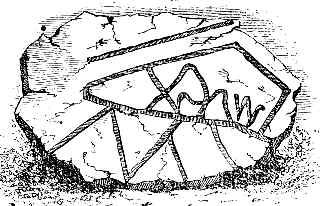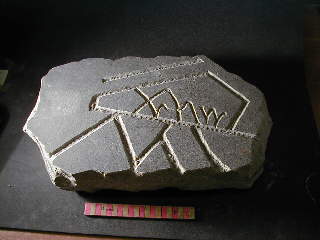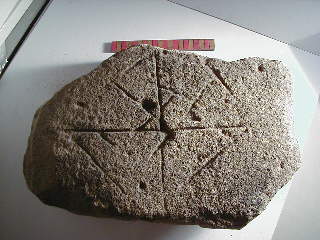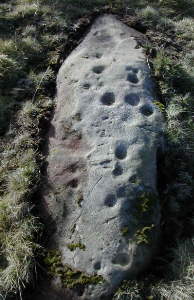Rock Carvings on the North York Moors
The prehistoric remains on the Eston Hills attracted
nineteenth century barrow diggers from nearby towns, and sadly even at
this date they reported that most of the barrows they investigated had
previously been disturbed.
In his "History and Antiquities of Cleveland" (1846) J.W. Ord described two barrows he dug on Eston Moor, in one of these he found a large urn covered by a stone marked with an arrangement of linear channels. (The original stone was lost but a replica exists at the Dorman Museum, apparently a copy of the engraving in Ord's book ( Fig A and Photo B)
UPDATE spring 2003
Paul Brown has photographed all the moors rock art held by the various
museums and archaeological establishments in the region and his photo of
the "Ord" replica in the Dorman museum is shown on the right.(B)
A visit to Tees Archaeology also uncovered a marked rock (C) for
which they had no information and after studying the images both Paul and
myself suggest this may be the original marked stone found by Ord.
In support of this Blaise Vyner has also pointed out the the engravings in
Ord's book may not be "accurate portrayals" of the finds he
uncovered. (Vyner 1991)
Excavations this century at the hillfort on Eston Nab, located a large cup
marked boulder on the earthworks along with several more cup marked stones
from the site, and at a later date a cup and ring marked stone plus 4 cup
marked stones were found in the drystone walls nearby. These carved stones
may have come from destroyed cairns/barrows, as one mound still exists
inside the hillfort and several more survive in the area.
Dave Heslop noted a possible cup marked boulder near the barrow on open
heathland to the south west of the hillfort.
(Eston Moor Cup marked stone (D)
Photo by Paul Brown)



